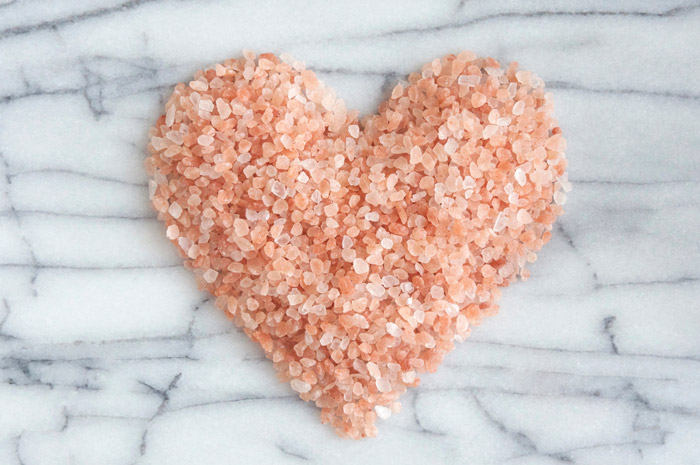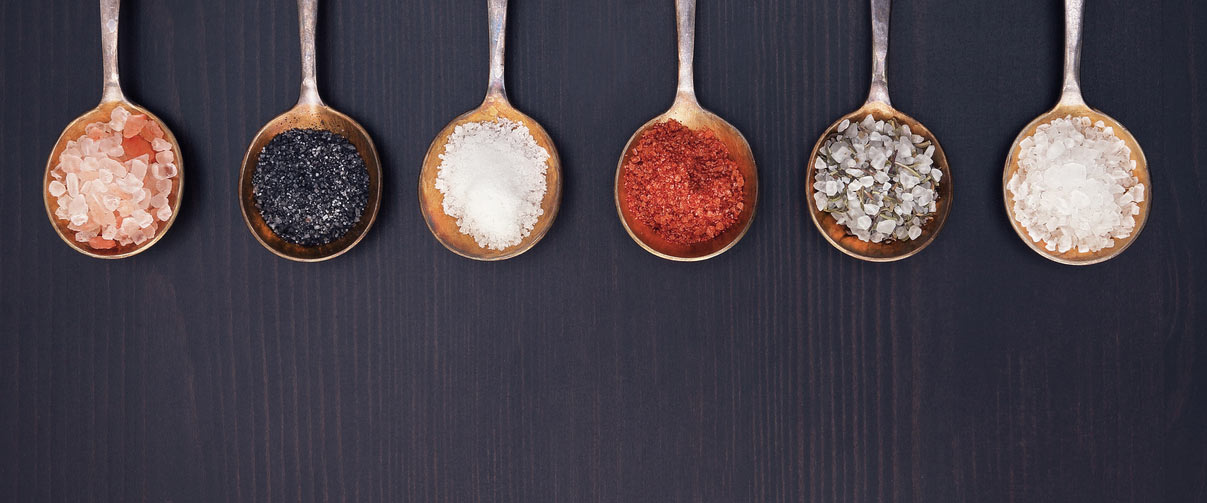Americans love to talk about salt. Sometimes chefs will argue a meal needs more of it, other times doctors will recommend waistlines see less of it. And then suddenly a holistic nutritionist blooms out of the ground from their grassroots movement, preaching that one salt trumps another. A nutrition scientist slaving over research studies fires back. Meanwhile I’m just becoming salty and purchasing whichever color is most appealing. If this sounds like you, don’t worry. You aren’t alone. For a while, I was clueless that there were more kinds of salts beyond the basic shaker sitting on my table. Thankfully, it’s not too vast of a language to understand, and I’ve broken down the most buzz worthy of terms. Let’s take our viewing experience of The Cooking Network to the next level – here are five of the most popular salt types discussed in the media today.
1. Kosher
 This salt’s craggy crystals are perfect for curing meat, which is how it found its name and rightful place in the koshering process. It’s fast dissolving, so chefs love to generously toss this condiment onto anything and everything they’re cooking. Its coarse texture makes it easy to pinch and sprinkle on food in perfect portions. In other words, I highly recommend you use this kind of salt if you’re striking the #SaltBae pose.
This salt’s craggy crystals are perfect for curing meat, which is how it found its name and rightful place in the koshering process. It’s fast dissolving, so chefs love to generously toss this condiment onto anything and everything they’re cooking. Its coarse texture makes it easy to pinch and sprinkle on food in perfect portions. In other words, I highly recommend you use this kind of salt if you’re striking the #SaltBae pose.
2. Sea Salt
Sea salt is created via evaporation of ocean or lake water with little processing involved. Different water sources will leave behind different combinations of trace minerals, creating various kinds of sea salts in different colors and subtle flavors. A popular sea salt would be Flaked Sea Salt, a condiment great for salads and fresh vegetables. Its dry crystals are known for packing a bright, sparkly punch. In comparison to other sea salts, such as fleur de sel or sel gris, they contain much lower traces of minerals.
3. Infused Salt
Essentially, its sea salt again. But this time, the salt is combined with spices, herbs and other flavorings. This topping is a sneaky tool a chef can use to achieve a flavor that may be too expensive or difficult to achieve in her current situation. Popular flavors include chocolate, lemon, vanilla or saffron. A classic example of this salt in action would be lemon infused salt sprinkled on top of plain grilled asparagus. How bougee!
4. Himalayan Pink Salt
This is the big one – I’m sure you’ve heard about it a lot. Himalayan Pink is a type of rock salt, originating from oceans that dried up millions of years ago. After having transformed within the earth’s crust for so long, this salt is much like sea salt in that it too possesses traces of mineral content. With no moisture, this salt packs an intense punch. It’s the most popular alternative to table salt and is typically dispensed through a salt grinder.

A lot of people praise Himalayan Pink as the superior, boasting over 84 minerals and elements found in the human body. Meanwhile, sea salt is said to becoming increasingly processed and contaminated due to the growing pollution in our waters. Presumably, Himalayan Pink must be the purest salt available given the pristine condition it’s kept in over the years. Unfortunately these claims have recently been blown out of proportion by eager marketing teams. What I mean is, don’t get caught up in the drama. The amount of minerals in Himalayan Pink are so miniscule that if you’re relying on a salt to get the micronutrients you need, and not whole foods, you’ve got bigger problems. There is no evidence published in peer-reviewed journals that prove replacing table salt with Himalayan Pink is going to boost your health or save a life. Plus, scientists have found countless unhealthy minerals in the salt as well: radium, uranium, thallium and polonium. Of course, these are too small in quantity to be harmful, but why don’t marketers mention these elements? Well, because it doesn’t sell. You see where I’m going with this?
5. Table Salt
And finally, the salt you love to hate. Classic table salt is mined from underground salt deposits. It’s usually refined and processed to remove all minerals and additives may also be used to prevent clumping. However, iodine is typically added back in to promote thyroid health.
So, which one is the healthiest?
No matter the salt you choose, every option is basically the same sodium chloride. The differences come from their varying combinations of trace minerals, which define unique textures, tastes and colors. As I mentioned before with Himalayan Pink, marketers love to utilize consumer confusion to the benefit their bottom line. They may claim a type of salt is superior, but unless there is solid scientific research to back such statements I would remain skeptical. Companies will do what they can to make a profit, so it’s up to us, the consumers, to stay mindful and knowledgeable about our choices. Salt should only be consumed in small amounts anyways; the Dietary Guidelines for Americans recommends (on average) less than 2,300 mg a day. I wouldn’t strain over picking the right salt. It’s not meant to make our food nutritional – it’s meant to make our food delicious!




